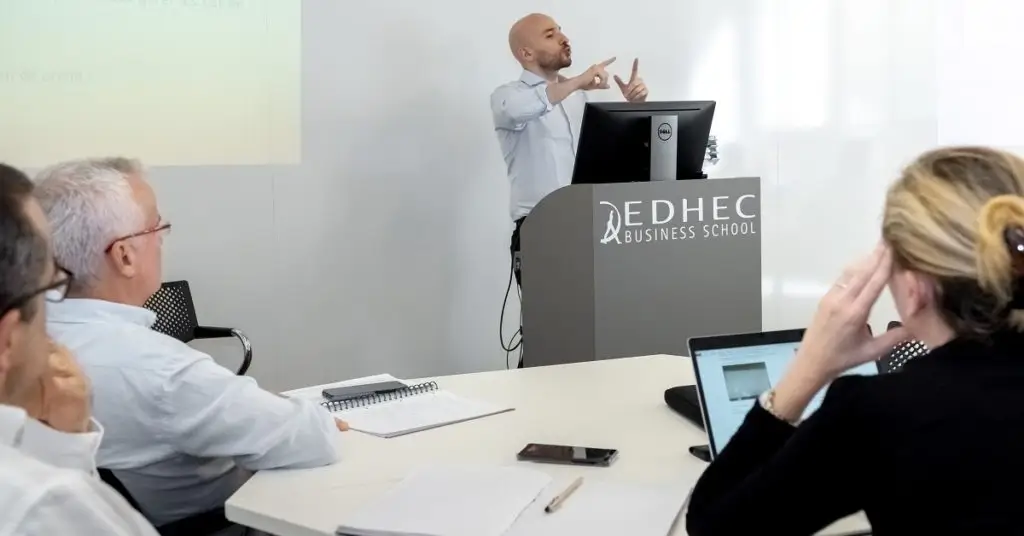Remote professional coaching is not exactly new. According to a 2019 coaching survey for business executives, it might even account for over 30% of all coaching services provided. This figure has been steadily increasing over the past seven years.
Moreover, it is clear that the trend accelerated in 2020. Lots of professional training and coaching has, of course, moved online due to the health crisis, and it’s a safe bet that this will continue over the coming years. This development promises to widen the gap with face-to-face coaching in favour of virtual sessions.
This recent change has naturally been tweaked to keep coachees’ attention, for example, and new tools have appeared to facilitate distance coaching. In this article, we will study the methods and best practices of this type of coaching.

When Distance Coaching Interferes with Professional Training
But, before we start, what is coaching, and how can we differentiate it from professional training? In the world of work, distance or face-to-face coaching comes under skills development. It has also gradually established itself to support the economic and technological developments that workers must adapt to nowadays.
More precisely, it is the soft skills (or personal, emotional and relational skills) that are becoming increasingly valued and sought after by recruiters and managers. It is in this context that coaching began to gradually mix with traditional training formats. Qualities such as adaptability, initiative and conflict resolution do seem easier to teach in this way.
In this sense, the very posture of the coach is different from that of the trainer. Although the latter is positioned primarily on an informational or technical level, the coach allows more room to listen to their coachee. The relationship between coach and coachee is thus much more horizontal than between teacher and student. It is based on psychological aspects intended to allow the coachee to find solutions themself, as well as participate in the development of the programme or identify the steps to be followed in order to validate their new skills.
As Muriel Cauvin, coach for the EDHEC Online Programme Manager training programme summarises: “Being coached is finding new energy and strength, and learning to believe in yourself. A bit like in sport, the coach has a role of transmitting energy!”
However, coaching, distance or not, does not replace professional training for many specialists, as professional training remains essential to developing a good knowledge of your sector and key know-how.
What are the goals of professional coaching?
Coaching is therefore the most effective way to reveal the hidden or undervalued strengths of each employee, but also to maintain their commitment to their profession and instill in them a desire to progress.
Professional coaching is a practice that varies greatly depending on the people supported. Moreover, the objectives of coaching will logically never be the same! That means that there can be different objectives when you are accompanied by a coach as part of your career:
- generating performance results that meet your company’s needs;
- getting up to speed on certain skills and developing your soft skills (particularly in terms of leadership, innovation and communication);
- creating and maintaining a posture in which the coachee is happy in their work and company;
- learning to establish constructive working relationships;
- preparing for promotion or transition to a new job;
- being able to optimise the use of your time for a higher impact;
- implementing positive, effective and efficient procedures for team meetings;
- etc.
Whatever the objective, professional coaching is intended to be a springboard which takes the personality and aspirations of each individual into account. However, where the objective remains intrinsically similar, coaching can take on several formats, such as distance, face-to-face, individually or in groups. Which format is best and how can you take advantage of it in your career?
Are Distance Coaching and Face-to-Face Coaching So Different?
As coaching aims to strengthen soft skills, it may seem counter-intuitive to do it online. After all, the bond built between coach and coachee is extremely important. Non-verbal communication (especially body language) will have a huge impact on the way in which the coach directs their support.
The challenge, therefore, is to create a connection of trust and a positive dynamic, especially for what is called life coaching, when the coachee encounters problems with self-confidence, assertion or positioning within a team. This is also the case for leader and group coaching, or when the goal is to remove barriers or hostile behaviour that could prevent a company from running smoothly.
Nevertheless, a coach and coachee can still meet through distance sessions, despite common belief. It is still possible to establish a support relationship on the screen to replace face-to-face coaching. Current tools also allow the coach to pick up on the non-verbal elements mentioned above.
As Muriel Cauvin explains in a detailed article on the conditions for good distance coaching, “Intuitively, we may fear that distance coaching loses its impact and that the screen plays an emotional filtering role, creating too great a distance from the participant. In reality, the only real prerequisite for effective distance coaching is technical: you have to have a stable videoconference tool to rely on. If the image is crisp and the sound clear, the link will be established.”
And, with a combination of the right tools, distance coaching can sometimes even be more effective than its face-to-face counterpart.
The Significant Advantages of Digital Support
Some people believe that distance coaching allows coachees to open up more easily than in a face-to-face setting, as they will feel less vulnerable and express themselves more confidently behind the screen. In its digital version, coaching makes it possible to tackle certain key aspects more quickly, and therefore to progress more quickly than during traditional sessions.
Furthermore, we cannot deny the practical and financial advantages of distance coaching, as it has the advantage of being able to conduct sessions wherever the coach and the coachee are and reduce travel costs when they are far apart. Distance coaching also meets time and efficiency requirements for managers.
Does professional coaching really work from a distance?
Despite these advantages, many professionals are still wary of distance coaching. However, there is a body of research that suggests that the results obtained with virtual coaching are relatively similar to those of face-to-face coaching.
This article presents coachee satisfaction and the results obtained are presented as comparable. Another Coach Federation article (The Virtues of Virtual Coaching, published in 2018) concluded that there was “no difference in the degree of resolution of the issues reported between face-to-face and distance coaching clients.”
However, it is sometimes essential to be in the same room, or it is simply preferable to a virtual session. This is particularly the case when observing the client in specific situations, such as during a work meeting or in their communication with the members of their team. Face-to-face coaching is also more effective in developing certain skills (especially emotional and interpersonal skills).
The distance format needs to be adapted slightly for group coaching, as coaches must identify the right tools to create scenarios or rely on improvisation. The only real “risk” of distance coaching is ultimately that the emergence of the coachee’s feelings and way of thinking and of acting may be less perceptible for the coach, which can slow down the coachee’s progression.
Favour Blended Coaching
We can therefore conclude that implementing professional coaching somewhere between completely online and completely in person is perhaps the optimal solution. In the current context, distance coaching is an excellent way to maintain contact and continue learning key professional skills (adaptation in particular). However, it is best to combine it with both a face-to-face and a group experience.
More generally, coaching and being coached in the digital era requires methods and tools to be adapted in order to integrate the advantages and disadvantages of distance, including the spontaneity of interactions. It is up to the coach to identify which solutions are really relevant to the content of their coaching and the objectives they wish to achieve, and it is up to the coachee to know which format best corresponds to their preferences and expectations!



